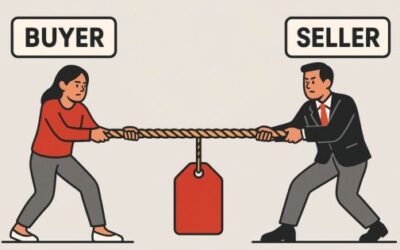This is a common mistake I see in the sales world. So many people are constantly searching for others to handle things for them. I’ve always been a firm believer in the power of sales coaching. When I say that I don’t mean pushing reps to hit their numbers. I mean investing time in each of them to make them better individually in an effort to improve the performance of the team.
Some coaches out there, they’ve got it all wrong. They think it’s all on the rep, that they should take 80% or 100% of the responsibility for their own development. That’s not the way to create a winning sales team. As coaches, we play a pivotal role in shaping their success.
That said, effective sales coaching is a two-way street. I’ve noticed that sales folks often rely too heavily on their coach, manager, or teammates to do the heavy lifting, expecting to be shown exactly how to execute every step. But, we’ve gotta face the truth here: the coach can’t do it all for you. It’s a shared responsibility. Each party has a distinct role to play on this journey. You need to find the balance and strategies where both sides contribute.
Sales Coaching Playbook
Observe
I’ll break down how I see it. From the coach’s perspective, it’s a three step process I like to call “observe, describe, prescribe.” Our primary duty as coaches is to keenly observe, monitor, and thoroughly assess what our salespeople are doing. That means dedicating as much time as possible to watching them in action, listening to their interactions, and diving deep into their call recordings. Coaches need to be a detective carefully scrutinizing how their reps conduct their sales, how they manage their team, how they collaborate with the team, their deal strategy, pipeline management, etc.
Describe
One we’ve gathered all the necessary information, it’s time to describe what we’ve observed. The goal is not to point fingers or tell a rep what they’re doing wrong. That’s counterproductive to effective coaching. Instead, we want to provide precise, objective descriptions. It’s more “hey, when I watched you during that close, I noticed you did this” or “during our chat about your pipeline and deal strategy, I saw you approached it this way” and less “this approach is wrong and it should be this.” We want to provide concrete examples of their actions and then walk them through each one to help them self-assess and uncover why they chose to take that route.
Prescribe
Finally, wrap it up with the “prescription.” As coaches, our job is to offer alternative paths, different methods, and suggest better options. We’re the navigators, guiding the salespeople to additional information, fresh ideas, different perspectives, and refined approaches to help them improve. That’s the role of sales coaching – observe, describe, prescribe.
A Rep’s Role: Absorb, Adapt, Achieve
Shifting gears, from the seller’s side, it’s your duty to be a sponge. What I mean by that is, when your coach provides you with insights, don’t push back with “I don’t like this” or “that doesn’t make sense.” It’s not about arguing or disputing their words. Instead, absorb it all, let it sink in. Take it as valuable input and ask yourself, “how can I apply this?”
Here’s the deal, when your coach points out something you believe you’re already doing, that’s a good thing! If you’re not doing it, that’s okay too. Accept it, add it to your toolkit, and incorporate it into your approach. The key is to be receptive and ready to implement these insights for your own growth and success. It should be a straight forward process of absorbing and applying.
Uncovering Blind Spots
This is why this is so important. If you haven’t heard of Johari’s Window, go take a minute and look it up. In the theory, there’s something called the blind spot. The blind spot is that hidden part of yourself that you’re oblivious to, but everyone else around you sees crystal clearly. It’s what they know about you that you don’t know about yourself. And that blind spot can be excruciatingly detrimental.
The best sales coaches excel at identifying and addressing these blind spots. They’ll help you shine a light on those blind spots and work on eliminating them. Once you’ve been clued in on what they are, they’re no longer a blind spot. Now that you’re aware, it’s on you to take that awareness and put in the effort to improve.
Achieve: Practice
Improvement doesn’t happen after applying feedback once during a practice session. Improvement comes through relentless repetition creating a new muscle memory. Think of it like playing tennis – if your coach tells you your backhand is terrible and you tend to undercut (I don’t know anything about tennis, maybe this isn’t an actual problem, just go with it), well, you’re on the right track having acknowledged the issue.
But, taking the last 10 minutes to work on the drill he gave you won’t change the habit. Consistent practice on the court, against a wall, or in the hallway mirror is what takes a weak backhand and makes it a killer. It’s the same principle with your sales discoveries, deal strategy, or whatever else you’re being coached on. It’s the constant, deliberate practice that makes you better. (Though, I’m not positive practicing your discos in the mirror will be overly helpful.)
Eradicate Blind Spots
So bottom line, coaches, your job is all about rolling up your sleeves and diving into observation mode. You’ve got to be relentless in this. Your mission: eradicate those pesky blind spots. Your weapon is feedback. You’ve got to be a master of description, painting a clear picture of what you see. Your prescription pad should be ready to roll, filled with fresh ideas and innovative thoughts.
Your goal, above all else, is to expand to expand their awareness. You’re the guiding light that helps them navigate through the fog of their limitations. It’s a multifaceted role – observe, eliminate blind spots, provide detailed feedback, and prescribe new avenues of thought. This how you nurture growth in your sales teams.
Own Your Growth
Salespeople, your role is just as vital. It starts with absorbing any feedback, learning and truly understanding it, and then applying it daily. It’s not solely your coach’s responsibility. I challenge you, as individuals to invest in your own self development. Don’t sit around and wait for the coach to point things out. Conduct your own observations. Take a good look in the mirror and provide your own honest self-description. Don’t shy away from prescribing your own path to improvement.
Both sides of this equation, both the coach and the coachee, have to commit to this journey. When you bring it all together that’s when the sky becomes the limit. The possibilities are endless when both parties are all-in.






0 Comments